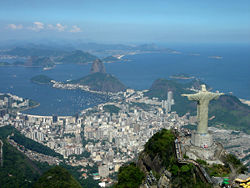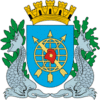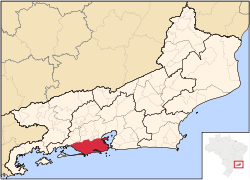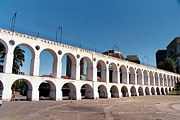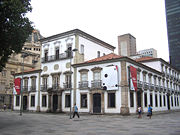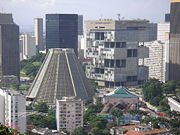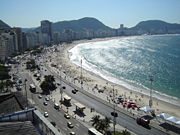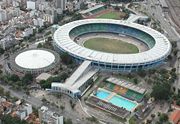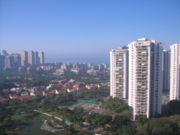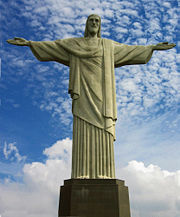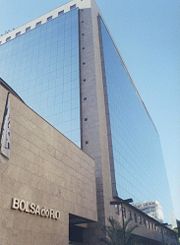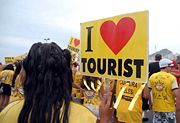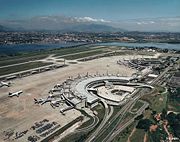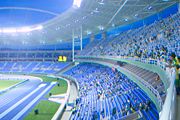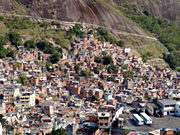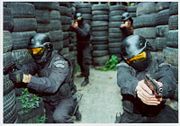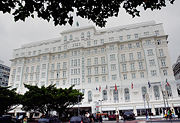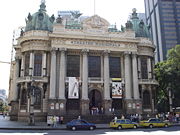Rio de Janeiro
2008/9 Schools Wikipedia Selection. Related subjects: Central and South America; Cities
| Rio de Janeiro | |||
| — Municipality — | |||
| The Municipality of São Sebastião do Rio de Janeiro |
|||
| View of Rio de Janeiro | |||
|
|||
| Nickname(s): Cidade Maravilhosa ("The Marvelous City") or simply, Rio | |||
| Location in the State of Rio de Janeiro | |||
| Coordinates: | |||
|---|---|---|---|
| Country | |||
| Region | Southeast | ||
| State | |||
| Founded | March 1, 1565 | ||
| Government | |||
| - Mayor | César Maia ( DEM) | ||
| Area | |||
| - Municipality | 1,260 km² (486.5 sq mi) | ||
| Population (2007) | |||
| - Municipality | 6,093,472 ( 2nd) | ||
| - Density | 4,781/km² (12,382.7/sq mi) | ||
| - Metro | 11,714,000 | ||
| Time zone | BST ( UTC-3) | ||
| - Summer ( DST) | BDT ( UTC-2) | ||
| Website: Rio de Janeiro City Hall | |||
Rio de Janeiro ("River of January", pronounced [ˈhiw dʒi ʒʌˈnejɾu] in Brazilian Portuguese, /ˈriːoʊ di ʒəˈnɛroʊ/ in English), is the second major city of Brazil, behind São Paulo. The city is capital of the state of Rio de Janeiro. It was the capital of Brazil for almost two centuries—from 1763 to 1822 while it was a Portuguese colony and from 1822 to 1960 as an independent nation. It was the de facto capital of the Portuguese Empire from 1808 to 1821. Commonly known as just Rio, the city is also nicknamed A Cidade Maravilhosa — "The Marvelous City."
It is famous for its natural settings, its Carnival celebrations, samba and other music, and hotel-lined tourist beaches, such as Copacabana and Ipanema, paved with decorated black and cream swirl pattern mosaics known locally as "pedra portuguesa". Some of the most famous local landmarks in addition to the beaches include the giant statue of Jesus, known as Christ the Redeemer ('Cristo Redentor') atop Corcovado mountain, which has recently been named one of the New Seven Wonders of the World; Sugarloaf mountain (Pão de Açúcar) with its cable car; the Sambódromo, a giant permanent parade stand used during Carnival; and Maracanã stadium, one of the world's largest football stadiums. Rio also boasts the two world's largest forests inside an urban area. The first is the forest in Parque Estadual da Pedra Branca, or White Stone State Park. The second, almost connected to the first, is the famous Floresta da Tijuca, or ' Tijuca Forest'.
The Galeão - Antônio Carlos Jobim International Airport connects Rio de Janeiro with many Brazilian cities and also operates several international flights.
Despite its charm and beauty, Rio is reputed to be one of the most violent cities in the world.
Geography
| Climate chart for Rio de Janeiro | |||||||||||
|---|---|---|---|---|---|---|---|---|---|---|---|
| J | F | M | A | M | J | J | A | S | O | N | D |
|
114
29
23
|
105
28
23
|
103
28
23
|
137
27
22
|
86
26
21
|
80
25
19
|
56
24
18
|
50
23
17
|
87
24
18
|
88
25
20
|
96
27
21
|
169
28
22
|
| temperatures in °C precipitation totals in mm source: MSN Weather |
|||||||||||
|
Imperial conversion
|
|||||||||||
Rio de Janeiro is located at 22 degrees, 54 minutes south latitude, 43 degrees 14 minutes west longitude. The population of the City of Rio de Janeiro is about 6,136,652, occupying an area of 1,182.3 square kilometres (456.5 sq mi). The population of the larger metropolitan area is estimated at 11-12 million. It was Brazil's capital until 1960, when Brasília took its place. Residents of the city are known as Cariocas. The city's current mayor (2006) is Cesar Maia. The official song of Rio is "Cidade Maravilhosa" (translated as "Marvelous City").
Climate
Rio has a Tropical climate. The temperature occasionally reaches over 40°C (104°F) in inland areas of the city, and maximum temperatures above 30°C (86°F) can happen every month. In the main tourist areas (south side, where the beaches are located), the temperature is moderated by the cool sea-breezes from the ocean. The average annual minimum temperature is 20°C (68°F), the average annual maximum temperature is 26°C (79°F) and the average annual temperature is 23°C (73.5°F). The average yearly precipitation is 1,086 mm. The minimum temperature ever registered was 4°C (40°F) in July 1928, but temperatures around 7°C (54°F) are rare in most of city, the absolute maximum reached 43.8°C (110°F) in January 1984.
History
Guanabara Bay was reached by Portuguese explorers in an expedition led by Portuguese explorer Gaspar de Lemos on January 20, 1502; hence Rio de Janeiro, "January River." There is a legend that the mariners named the place thus because they thought the mouth of the bay was actually the mouth of a river, but no experienced sailor would make that mistake. At the time, river was the general word for any large body of water.
An unofficial European presence in the area began not long after. In 1519 when Ferdinand Magellan resupplied his ships in the bay, French smugglers were already using the bay as a post for smuggling brazilwood. When French naval officer Nicolas Durand de Villegaignon arrived in 1555 with a fleet of two ships and 600 soldiers and colonists, he founded the first permanent European settlement in the area. The colony was referred to as " France Antarctique". The colonists consisted of mainly French Huguenots and Swiss Calvinists. Villegaignon left in 1557 after disputes with some of the colonists.
The city was founded on March 1, 1565, by Portuguese knight Estácio de Sá, who called it São Sebastião do Rio de Janeiro 20 (St Sebastian of the January 20th River), in honour of Saint Sebastian (day of death traditionally on January 20). For centuries, the settlement was commonly called São Sebastião — or even 'Saint Sebastian' — instead of the currently popular second half of its name. The city was founded as a base from which to invade the French settlement. They succeeded in 1567 and the French were expelled. Later, São Sebastião was frequently attacked by pirates and privateers, especially by then enemies of Portugal, such as the Netherlands and France.
The exact place of Rio's foundation is at the foot of Pão-de-Açúcar (Sugarloaf Mountain). Later, the whole city was moved within a palisade on top of a hill, imitating the medieval European defense strategy of fortified castles — the place has since then been called Morro do Castelo (Castle Hill). Thus, the city developed from the current centre (Downtown, see below) southwards and then westwards (with large parts built over reclaimed land); an urban movement which continues today.
In the late 16th century, the Portuguese crown began treating the village as a strategic location for the Atlantic transit of ships between Brazil, the African colonies and Europe. Fortresses were built and an alliance was formed with nearby native tribes to defend the settlement. Invaders — Rio's neighbour, Niterói, for instance, was founded by Araribóia, a Tamoio Indian chief, for defensive purposes. Sugar cane was the first industry in the area. First native, and later African, slaves were used for manual labor. Eventually the industry dwindled as higher quality sugar cane from northern Brazil became more available.
Until early in the 18th century, the city was threatened or invaded by several, mostly French pirates and buccaneers, such as Jean-François Duclerc and René Duguay-Trouin. After 1720, when the Portuguese found gold and diamonds in the neighboring captaincy of Minas Gerais, Rio de Janeiro became a much more useful port for exporting wealth than Salvador, Bahia, which is much farther to the north. In 1763, the colonial administration in Portuguese America was moved to Rio. The city remained primarily a colonial capital until 1808, when the Portuguese royal family and most of the associated Lisbon nobles, fleeing from Napoleon's invasion of Portugal, moved to Rio de Janeiro. The kingdom's capital was transferred to the city, which, thus, became the only European capital outside of Europe. As there was no physical space or urban structure to accommodate hundreds of noblemen who arrived suddenly, many inhabitants were simply evicted from their homes.
When Prince Pedro I proclaimed the independence of Brazil in 1822, he decided to keep Rio de Janeiro as the capital of his new empire. Rio continued as the capital of Brazil after 1889, when the monarchy was replaced by a republic.
Until the early years of the 20th century, the city was largely limited to the neighborhood now known as the historic Downtown business district (see below), on the mouth of Guanabara Bay. The city's centre of gravity began to shift south and west to the so-called Zona Sul (South Zone) in the early part of the 20th century, when the first tunnel was built under the mountains located between Botafogo and the neighbourhood now known as Copacabana. That beach's natural beauty, combined with the fame of the Copacabana Palace Hotel, the luxury hotel of the Americas in the 1930s, helped Rio to gain the reputation it still holds today as a beach party town (though, this reputation has been somewhat tarnished in recent years by favela violence resulting from the narcotics trade). Plans for moving the nation's capital city to the territorial centre had been occasionally discussed, and when Juscelino Kubitschek was elected president in 1955, it was partially on the strength of promises to build a new capital. Though many thought that it was just campaign rhetoric, Kubitschek managed to have Brasília built, at great cost, by 1960. On April 21 that year the capital of Brazil was officially moved from Rio de Janeiro to Brasília.
Between 1960 and 1975 Rio was a capital city, such as Vienna, Austria or Washington, D.C. (United States), under the name State of Guanabara (after the bay it borders). However, for administrative and political reasons, a presidential decree known as "The Fusion" removed the city's federative status and merged it with the state of Rio de Janeiro in 1975. Even today, some Cariocas advocate the return of municipal autonomy.
City districts
The city is commonly divided into the historic downtown (Centro); the tourist-friendly South Zone (Zona Sul), with its world-famous beaches; the residential North Zone (Zona Norte); and the West Zone (Zona Oeste), with the newer Barra da Tijuca district.
Downtown
()
Centro (Downtown in American English or CBD in other English use) is the historic centre of the city, as well as its financial centre. Sites of interest include the Paço Imperial, built during colonial times to serve as a residence for the Portuguese governors of Brazil; many historic churches, such as the Candelária Church, the colonial Cathedral and the modern-style Rio de Janeiro Cathedral. Around the Cinelândia square there are several landmarks of the Belle Époque of Rio, such as the Municipal Theatre and the National Library building. Among its several museums, the Museu Nacional de Belas Artes (National Museum of Fine Arts) and the Museu Histórico Nacional (National Historical Museum) are the most important. Other important historical attractions in central Rio include its Passeio Público, an 18th century public garden, as well as the imposing arches of the Arcos da Lapa, a Roman-style aqueduct built around 1750. A bondinho (tram) leaves from a city centre station, crosses the aqueduct (converted to a tram viaduct in 1896) and rambles through the hilly streets of the Santa Teresa neighbourhood nearby.
Downtown remains the heart of the city's business community. Some of the largest companies in Brazil have their head offices here, including Petrobras and Vale (formerly Companhia Vale do Rio Doce), the two largest Brazilian corporations.
South Zone
()
The South Zone of Rio de Janeiro (in Portuguese: "Zona Sul") is composed of several districts, amongst which are São Conrado, Leblon, Ipanema, Arpoador, Copacabana and Leme, which compose Rio's famous Atlantic beach coastline. Other districts in the South Zone are Glória, Flamengo, Botafogo and Urca, which border Guanabara Bay and Santa Teresa, Cosme Velho, Laranjeiras, Humaitá, Lagoa, Jardim Botânico and Gávea. It is the richest region of the city and the most famous overseas.
The neighbourhood of Copacabana beach hosts one of the world's most spectacular New Year's Eve parties ("Reveillon"), as more than two million revelers crowd onto the sands to watch the fireworks display. As of 2001, the fireworks have been launched from boats, to improve the safety of the event. To the north of Leme, and at the entrance to Guanabara Bay, is the district of Urca and the Sugarloaf Mountain ('Pão de Açúcar'), whose name describes the famous mountain rising out of the sea. The summit can be reached via a two-stage cable car trip from Praia Vermelha, with the intermediate stop on Morro da Urca. It offers views second only to Corcovado mountain.
One of the highest hills in the city is the 842 metres (2,762 ft) high Pedra da Gávea ( Crow's nest Rock) near the botanical gardens. On the top of its summit is a huge rock formation (some, such as Erich von Däniken in his 1973 book, "In Search of Ancient Gods", claim it to be a sculpture) resembling a sphinx-like, bearded head that is visible for many kilometers around.
Hang gliding is a popular activity on the nearby Pedra Bonita (Beautiful Rock). After a short flight, gliders land on the Praia do Pepino (Cucumber Beach) in São Conrado. Since 1961, the Tijuca Forest ("Floresta da Tijuca"), the largest city-surrounded urban forest and the second largest urban forest in the world, has been a National Park. The largest urban forest in the world is the Floresta da Pedra Branca (White Rock Forest), which is also located in the city of Rio de Janeiro. The Catholic University of Rio ( Pontifícia Universidade Católica do Rio de Janeiro or PUC-Rio) is located at the edge of the forest, in the Gávea district. The 1984 film Blame it on Rio was filmed nearby, with the rental house used by the story's characters sitting at the edge of the forest on a mountain overlooking the famous beaches.
North Zone
The North Zone of Rio (in portuguese: "Zona Norte") is home to the Maracanã stadium, once the world's highest capacity football (soccer) venue, able to hold nearly 180,000 people, as it did the World Cup final of 1950. In modern times its capacity has been reduced to conform with modern safety regulations and the stadium has introduced seating for all fans. Currently undergoing renovation, it has now the capacity for 95,000 fans; it will eventually hold around 120,000 people. Maracanã was site for the Opening and Closing Ceremonies and football competition of the 2007 Pan-American Games.
Besides the Maracanã, the North Zone of Rio also holds other tourist and historical attractions, such as 'Manguinhos', the home of Instituto Oswaldo Cruz, a centenarian biomedical research institution with a main building fashioned like a Moorish palace, and the beautiful Quinta da Boa Vista, the park where the historical old Imperial Palace is located. Nowadays, the palace hosts the National Museum, specializing in Natural History, Archaeology and Ethnology.
The International Airport of Rio de Janeiro (Galeão – Antônio Carlos Jobim International Airport, named after the famous Brazilian musician "Tom" Jobim), the main campus of the Federal University of Rio de Janeiro at the Fundão Island, and the State University of Rio de Janeiro, in Maracanã, are also located in the Northern part of Rio.
This region is also home to most of the Samba Schools of Rio de Janeiro such as Mangueira, Salgueiro, Império Serrano, Unidos da Tijuca, among others. Some of the main neighbourhoods of Rio's North Zone are Tijuca — which shares the Tijuca Rainforest with the South Zone — Grajaú, Vila Isabel, Méier, São Cristovão Madureira and Olaria among others.
West Zone
The West Zone (in portuguese: "Zona Oeste") is the region furthest from the centre of Rio de Janeiro. It includes Barra da Tijuca, Jacarepaguá, Recreio dos Bandeirantes, Vargem Grande, Vargem Pequena, Realengo, Padre Miguel, Bangu, Campo Grande, Jardim Sulacap, Paciência and Santa Cruz. Neighbouring districts within the West Zone reveal stark differences between social classes. The area has industrial zones, but some agricultural areas still remain in its wide area.
Westwards from the older zones is Barra da Tijuca, a flat expanse of formerly undeveloped coastal land, which is currently experiencing a wave of new construction. It remains an area of accelerated growth, attracting some of the richer sectors of the population as well as luxury companies. High rise flats and sprawling shopping centres give the area a far more American feel than the crowded city centre. The urban planning of the area, made in the late 1960s, resembles that of United States suburbs, though mixing zones of single-family houses with residential skyscrapers. The beaches of Barra da Tijuca are also popular with the city's residents. Barra da Tijuca is the home of Pan-American Village for the 2007 Pan American Games.
Beyond the neighbourhoods of Barra da Tijuca and Jacarepaguá, another district that has exhibited economic growth is Campo Grande. Some sports competitions in the Pan-American Games of 2007 were held in the Miécimo da Silva Sports Centre, nicknamed the 'Algodão' (Cotton) Gymnasium, and others in the Ítalo del Cima Stadium, in Campo Grande.
Demographics
According to the IBGE of 2007, there were 11,714,000 people residing in the Metropolitan Region of Rio de Janeiro. The population density was 4.781 inh./km². The last PNAD (National Research for Sample of Domiciles) census revealed the following percentage: 6,278,704 White people (53.6%), 3,935,904 Brown people (33.6%), 1,440,822 Black people (12.3%) and 58,000 Asian or Amerindian people (0.5%).
Different ethnic groups contributed to the formation of the population of Rio de Janeiro. Before European colonization, there were at least seven different indigenous peoples speaking 20 languages in the region. A part of them joined the Portuguese and the other the French. Those who joined the French were then exterminated by the Portuguese, while the other part was assimilated.
Rio de Janeiro is home to the largest Portuguese population outside of Lisbon. The Portuguese community (the oldest in the city) has left a remarkable legacy to Rio de Janeiro since the 16th century. After independence, Rio de Janeiro remained gateway for thousands of Portuguese immigrants, mainly in the first decades of the 20th century. They were mainly poor peasants who, later, found prosperity in Rio as small traders. Besides the influence on ethnicity, the Portuguese left its architecture and also the accent of the inhabitants of Rio de Janeiro, which sounds more Portuguese than the other Brazilians.
The black community, whose ancestors were brought as slaves, had a great impact in the composition of Rio's population. Nowadays, nearly half of its population is Black or part-Black. Most of the slaves in Rio came from Angola or Mozambique. Rio's carnival, with its samba, is probably the most remarkable influence from the black community.
As a result of the diversity of immigrants who came to Brazil between the end of the 19th and early 20th centuries, one may find in Rio de Janeiro many Jews, Arabs of Lebanese and Syrian origin, Italians, Spaniards, Germans and people from different parts of Brazil.
Religion
| Religion | Percentage | Number |
| Catholic | 60.71% | 3,556,096 |
| Protestant | 17.65% | 1,034,009 |
| No religion | 13.33% | 781,080 |
| Spiritist | 3.44% | 201,714 |
| Umbandist | 0.4% | 72,946 |
| Jewish | 0.72% | 23,862 |
Source: IBGE 2000.
Economy
Rio de Janeiro became an attractive place for companies to locate when it was the capital of Brazil, as important sectors of society and of the government were present in the city. The city was chosen as headquarters for state-owned companies such as Petrobras, Caixa Econômica Federal and Vale do Rio Doce (which was privatized in the 1990s). After the transfer of the capital to Brasília, in 1960, it kept attracting more companies, especially after the discovery of oil in the Campos Basin, which produces most of the total oil production of Brazil. This made many oil and gas companies to be based in Rio de Janeiro, such as the Brazilian branches of Shell, EBX and Esso. The headquarters of BNDES, an important state institution, is also in Rio de Janeiro. The city is also the headquarters of large telecom companies, such as Intelig, Oi and Embratel.
Major Brazilian entertainment organizations are based in Rio de Janeiro like TV Globo ( Globosat, Globo News, SportTv, Telecine, Tv Brazil), NET, Sky and WayBrazil and also some of Brazil's major newspapers: Jornal do Brasil, O Globo, O Dia, and Business Rio.
Major international pharmacuetical companies have their Brazilian headquarters in Rio such us Merck, Roche, Arrow, Darrow, Baxter, Mayne, and Mappel.
The GDP for the city was R$ 118,979,752,000 (2005).
The per capita income for the city was R$ 19,524 (2005).
Education
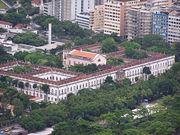
Portuguese is the official national language, and thus the primary language taught in schools. But English and Spanish are part of the official high school curriculum.
Educational institutions
- Universidade Federal do Rio de Janeiro (UFRJ);
- Centro Federal de Educação Tecnológica (CEFET-RJ)
- Fundação Getúlio Vargas (FGV);
- Universidade Candido Mendes (UCAM);
- Escola Superior de Propaganda e Marketing (ESPM);
- Instituto Brasileiro de Mercados e Capitais (IBMEC);
- Instituto Militar de Engenharia (IME);
- Pontifícia Universidade Católica do Rio de Janeiro (PUC-Rio);
- Universidade Gama Filho (UGF);
- Universidade do Estado do Rio de Janeiro (UERJ);
- Universidade do Grande Rio (UNIGRANRIO);
- Universidade Federal do Estado do Rio de Janeiro (UNIRIO);
- Universidade Estácio de Sá
- Universidade Santa Úrsula
- Universidade Veiga de Almeida (UVA)
- and many others.
Culture
Music
The official song of Rio de Janeiro is "Cidade Maravilhosa", which means "marvelous city". The song is considered the "civic anthem" of Rio, and is always the favourite song during Rio's Carnival in February.
Rio de Janeiro is a very important place when studying the urban music of Brazil. They are responsible for the creation of Funk Carioca, which means funk from Rio de Janeiro. This music became a representation of the current problems residents faced in Rio. It became the largest movement in the city because it gave an outlet to many young people to voice their feelings and make money at the same time. It became a social outlet for the community of Rio de Janeiro. It provided places for the community to come together and appreciate the music and the culture in a peaceful manner. Race and class are ignored and people just celebrate their culture to their music.
Rio was eternalized in the super smash hit song " Garota de Ipanema" (The Girl from Ipanema) composed by Antonio Carlos Jobim and recognized worldwide and recorded by Astrud Gilberto and João Gilberto, Frank Sinatra, and Ella Fitzgerald. This is also the main key song of the bossa nova, a musical genre that was born in Rio.
A genre unique to Rio and Brazil as a whole is Funk Carioca. While samba music continues to act as the national unifying agent in Rio, Funk Carioca found a strong community following in Brazil. First introduced in the 1970s to refer to modern black pop music from the United States, such as James Brown, it evolved in the 1990s to describe a variety of electronic music associated with the current US black music scene including hip hop, modern soul, and house music. Recognizable by the bass of the beat box, funk music could be heard in the alley ways of lower-class neighborhoods in Rio throughout the mid-1990s. Dancing and interclass mixing were significant in the "funk movement."
Although not the capital city of Brazil, Rio has always been the symbol of Brazil's nationality and diverse social structure. While Samba is the national unifying agent, as Brazilian national politics developed in Rio, other forms of music were implemented into the national culture of Brazil. Brazil's return to democracy in 1985 after over 20 years if military authoritarian rule, and the subsequent end of rampant censorship, allowed for a new freedom of expression which promoted creativity and experimentation in expressive culture.". This new expressive ability facilitated to access to better economic conditions and relative economic stability. This economic stability allowed for the consumption of imported goods such as hip hop. Commercial and cultural imports from Europe and North America have often influenced Brazil's own cultural output. For example, the hip hop that has stemmed from New York is localied into various forms of musial production such as Funk Carioca and Brazilian hip hop. Thus, Rio has been the most important site as the melting pot of talented composers and performers of all different musical backgrounds. Democratic renewal also allowed for the recognition and acceptance of this diversification of Brazilian culture.
In some cases, Funk Carioca is also connected to gang territorial dominance in Rio's slums. The gangs fund dance parties, known as bailes, to recruit new members, update each other on local news, and engage in selling drugs.
Rio de Janeiro, representing one of the largest urban areas in Brazil, is populated with a medley of ethnic types and identities. This diversity allows for it to be the major site for the country's music industry to thrive. Many active scholars in the study of pop culture, such as Livio Sansone, Samuel Araújo, and Martha Ulhoa and internationally renown recording artists such as Rick Devin are located in the heart of this city, proving it to be an imperative place for any aspiring pop culture artist to be.
Carnival
The Brazilian carnival (Carnaval, in Portuguese) is an annual celebration held 40 days before Easter and marking the beginning of Lent. Rio de Janeiro has many Carnival choices, including the famous Samba school (Escolas de Samba) parades in the sambadrome exhibition centre and the popular blocos de carnaval, which parade in almost every corner of the city. The most famous ones are:
- Cordão do Bola Preta: Parades in the centre of the city. It is one of the most traditional carnavals. In 2006, it gathered 200,000 people in one day.
- Suvaco do Cristo: Band that parades in the Botanic Garden, directly below the Redeemer statue's arm. The name, in English, translates as 'Christ's armpit', and was chosen for that reason.
- Carmelitas: Band that was supposedly created by nuns, but in fact it is just a theme chosen by the band. It parades in the hills of Santa Teresa, which have very nice views.
- Simpatia é Quase Amor: One of the most popular parades in Ipanema. Translates as 'Friendliness is almost love'.
- Banda de Ipanema: The most traditional in Ipanema. It attracts a wide range of revellers, including families and a wide spectrum of the gay population (notably spectacular drag queens).
In 1840 the first Carnaval was celebrated with a masked ball. As years passed, adorned floats and costumed revelers became a tradition amongst the celebrants. Carnaval is known as a historic root of Brazilian music.
Cultural events
Apart from Carnaval, New Year is also a major event in Rio. It's celebrated with concerts and firework displays all around Rio, the largest one being in Copacabana beach. People wear white clothes, and some of them make offerings to Iemanjá, a deity in many of the Afro-Brazilian religions (e.g. Candomble, Umbanda, Macumba).
There are several significant museums in Rio as well. Among them are the Quinta da Boa Vista (which includes the National Museum of Brazil), the Naive Art Museum (primitives, with the largest collection of naive paintings in the world), and the Indian Museum.
Rio also has one of the world's most talked-about nightlife. Rio has a lot of nightclubs where the rich enjoy themselves and party the night away. Clubs like Baronneti, Nuth, and Catwalk are some of the country's best known and frequented by celebrities such as Ronaldo, Calvin Klein, Mick Jagger, and Naomi Campbell.
Infrastructure
Airports
The City of Rio de Janeiro has five airports.
- Galeão - Antônio Carlos Jobim International Airport: used for all the international flights and some long-haul domestic flights;
- Santos Dumont Regional Airport: Rio de Janeiro's first airport, and formerly the International Airport. It is considered one of the best-located airports in the world because of its location between Sugar Loaf, Corcovado, the Aterro do Flamengo, and Guanabara Bay. Today it is used by the São Paulo — Rio de Janeiro Air Shuttle Service and some intrastate flights, especially to oil-producing cities in the north.
- Aeroporto de Jacarepaguá: In the Barra da Tijuca district. It is currently used by Aeroclube do Brasil (Brasil Flying Club) with small aircraft but is planned to be used for the Rio de Janeiro - São Paulo Air Shuttle Service since it is just inside Barra, the city's fastest-growing district. The Jacarepagua Airport is the biggest heliport of world too.
- Afonsos Air Base (Base Aérea dos Afonsos or Campo dos Afonsos): Military airport, where the Brazilian Air Force presents its aerobatic shows. It also holds the MUSAL (Museu Aero-Espacial), one of the largest aviation museums in Latin America.
- Santa Cruz Air Base (Base Aérea de Santa Cruz): Military airport.
Rio de Janeiro have other airports in other cities of state.
Transportation
In Rio de Janeiro, buses are the main means of mass transportation. There are nearly 440 municipal bus lines serving over four million passengers each day, in addition to intercity lines. Although cheap and frequent, Rio's transportation policy has been moving towards trains and subway in order to reduce traffic jams and increase capacity. Driving in Rio de Janeiro, as in most large cities of Brazil, might not be the best choice due to the large car fleet. The city is served by a number of expressways though traffic jams are very common.
Metro
Rio de Janeiro has two subway lines ( Metro Rio) with 42 km and 32 stations plus several commuter rail lines. Future plans include building a third subway line to Niterói and São Gonçalo, including an underwater tunnel beneath Guanabara Bay to supplement the ferry service currently there.
Train
Rio de Janeiro has a large and technologically advanced urban rail transportation system.
Highways
In Brazil, most interstate transportation is done by road. A large terminal for long-distance buses is in the Santo Cristo neighbourhood of Rio de Janeiro. There are also two port facilities for cargo and passenger ships (Rio de Janeiro and Sepetiba port). From São Paulo: take the BR 116 (Presidente Dutra Federal Highway) or the BR-101 (Rio-Santos Federal Highway). From Belo Horizonte: BR 040. From Salvador: BR-101 or BR-324/BR-116/BR-393/BR-040.
Distances
| Brasília: | 1,160 km (720 mi) |
| São Paulo: | 430 km (270 mi) |
| Belo Horizonte: | 450 km (280 mi) |
Port
The Port of Rio de Janeiro is visited by cruise boats, which travel along the Brazilian coast.
Sports
More notable sports events in Rio include the MotoGP Brazilian Grand Prix and the world beach volleyball finals. Jacarepaguá was the place of Formula One Brazilian Grand Prix into 1978-1990 and the Champ Car event into 1996-1999. WCT/WQS Surf championships were contested on the beaches from 1985-2001. The city has built a new stadium, Estádio Olímpico João Havelange, to hold 45,000 people. It was named after Brazilian ex-FIFA president João Havelange. The stadium is owned by the City of Rio de Janeiro, but it is rented to Botafogo de Futebol e Regatas for 20 years.
Rio de Janeiro was an applicant city for the 2012 Summer Olympics but failed to make the shortlist of official candidate cities. Copacabana beach would have been the site of the triathlon and beach volleyball, while yachting competitions would have been held in Guanabara Bay. On September 2006, it was announced that Rio would bid for 2016 Summer Olympics. Depending on the quantity and the quality of bids IOC will receive from other NOCs, IOC will probably announce a shortlist of official candidate cities in early 2008, and conduct voting for the host city in 2009.
Rio de Janeiro has also a multi-purpose arena, the HSBC Arena.
Sports are very popular pastime in Rio de Janeiro. The most popular one is futebol (soccer). Rio de Janeiro is home to five traditional Brazilian soccer clubs: América Football Club, Botafogo, Flamengo, Fluminense and Vasco da Gama.
The Brazilian dance/sport/ martial art capoeira is very popular. Other popular sports are beach football, beach volleyball, beach american football, surfing, kitesurfing, hang gliding, motor racing, jiu-jitsu, recreational sailing, and competitive rowing. Another sport that is highly popular in beaches of Rio is called "frescobol" (IPA: [fres.ko.'bɔu̯], matkot), a type of beach tennis.
Rio de Janeiro is also paradise for rock climbers, with hundreds of routes all over the town, ranging from easy boulders to highly technical big wall climbs, all inside the city. The most famous, Rio's granite mountain, the Sugar Loaf ( Pão de Açúcar), is an example, with routes from the easy 3rd grade (American 5.4, French 3) to the extremely difficult 9th grade (5.13/8b), up to 280 metres.
Hang gliding in Rio de Janeiro started in mid 1970s and quickly proved to be perfectly suited for this town, because of its geography: steep mountains encounter the Atlantic Ocean, which provide excellent take-off locations and great landing zones on the beach. Starting with amateur flights, this activity soon turned into a profitable industry of tandem hang gliding with some very experienced pilots at a cost for a ride around US$100. In the Summer, between December and March, booking in advance is recommended.
Fishing is a very popular activity in Brazil. In Rio de Janeiro, one can expect to catch a plethora of famous Brazilian copperfish, known as peixe de cobre. Many markets sell peixes de cobre and these fish are quite popular for traditional meals. No license is required for fishing in Brazil.
A fast-growing beach American football league is based in Rio, the Carioca Bowl.
Rio de Janeiro is one of the 18 remaining candidates to host games of the 2014 FIFA World Cup that will be hosted in Brazil.
Team Black House is located in Rio de Janeiro. Current members are UFC standouts Anderson Silva, Antonio Rodrigo Nogueira, and Lyoto Machida. Former UFC star Vitor Belfort is also a member.
Social conditions
There are enormous disparities between rich and poor in Rio de Janeiro. Although the city clearly ranks among the world's major metropolises, a large proportion of the city's 6.1 million inhabitants live in poverty. The poorest of the areas are the slums and shanty towns known as favelas; often crowded onto the hillsides, where sturdy buildings are difficult to build, accidents from heavy rainfall are frequent, and access to the sanitation and electricity can be inconsistent. A unique aspect of Rio's favelas is their close proximity to the city's wealthiest districts. Upper-class neighbourhoods such as Ipanema and Copacabana are squeezed in between the beach and the hills, the latter of which are covered with poor neighbourhoods. Bad public education, a poor health system combined with the saturation of the penitentiary system contribute to the overall poverty of the favelas. But the North Side, the poorest area of Rio that tourists rarely see, gathers the vast majority of Rio's famished and impoverished masses. This social contrast creates a clash between rich and poor.
Crime
Rio has high crime rates, especially homicide, in poor areas dominated by drug lords, primarily in the North Zone. As of 2007, the homicide rate of the greater metropolitan area stood at nearly 30 victims per week, with the majority of victims falling to mugging, stray bullets or narcoterrorism. In 2006, 2,273 people were murdered in the city giving it a murder rate of 37.7 cases for every 100,000 people. Note that these numbers have dropped considerably from 3,728 murders and a rate of 62.8 cases as registered in 2002; as a comparison, London's murder rate for 2006 was 2.2 cases for every 100,000 population. According to federal government research, the city itself ranks 206th in the list of the 5565 most violent cities in Brazil and first in total number of firearm-related deaths. Between 1978 and 2000, 49,900 people were killed in Rio. The Urban Warfare involves drug-traffic battle with police fighting against outlaws, or even corrupt policemen on their side.
Rio de Janeiro's low paid and ill-equipped police are violent as well, it has been said. In 2007, the police allegedly killed 1,330 people in the state, an increase of 25 percent over 2006 when 1,063 people were killed, in 2003 that number plateaued at 1,195. In comparison the American police killed just 347 people in whole of the United States during 2006. The average Rio policeman earns only R$874 a month or R$10,488 (around US$6,000) a year. Compounding the problem of crime is impunity. Only 3 percent of the murders are solved by Rio's police.
Human development
The human development of Rio varies greatly by locality. There are neighborhoods that had very high human development indexes in 2000 (equal to or greater than the indexes of some Scandinavian countries), but also those in the medium range (in line with, for example, North Africa).
Top neighborhoods and localities
- Gávea (0.970)
- Leblon (0.967)
- Jardim Guanabara (0.963)
- Ipanema (0.962)
- Lagoa (0.959)
Neighborhoods and localities in last place:
- Complexo do Alemão (0.711)
Lists
Parks and squares
- Flamengo Park - Large park in the Flamengo neighbourhood, beside Guanabara Bay.
- Rio de Janeiro Botanical Garden – Magnificent park founded in the early 19th century.
- Quinta da Boa Vista - Site of the palace used by the emperors of Brazil.
- Zoological Garden of Rio de Janeiro - Located in the Quinta da Boa Vista.
- Passeio Público - 18th century public garden in central Rio.
- Arpoador Park
- Parque Lage – Contains areas of woodland, gardens, aquaria and a children's playground. The School of Visual Art ( Escola de Artes Visuais do Parque Lage) occupies a luxurious early 20th century building faced with Italian marble and tiles. The buildings are protected as national monuments.
- Tijuca Forest - A huge rainforest that covers highlands which rise in the middle of the city. It is the first world's largest urban rainforest. There, people can find beauty, peace and they can gaze the luxurious variety of fauna and flora. Unfortunately, through the years, the forest is being threatened by illegal occupation, mainly slum which grows by the borders and put the integrity of the forest in danger. Besides it, the place remains wonderful and magic. A highly advisable place to visit.
Famous Cariocas
Cariocas, as residents of Rio de Janeiro are called in Brazil, have made extensive contributions to Brazil's history, culture, music, literature, education, science, technology etc. – particularly when Rio de Janeiro was the federal capital and a great hub of Brazilian growth and innovation in all these areas. Some important Cariocas, who were born in Rio, are:
|
|
Trivia
Rio has been used as a backdrop for many films, such as Academy Award-nominated Central do Brasil (Central Station, 1998) and Cidade de Deus (City of God, 2002); Moonraker (1979), Blame It on Rio (1984), Tropa de Elite (Elite Squad, 2007), The Incredible Hulk (2008), and of course classics like Orfeu Negro (Black Orpheus, 1959) and L'Homme de Rio (Man From Rio, 1964).
In The Simpsons episode " Blame it on Lisa", the family visited Rio de Janeiro in a search of a missing Brazilian orphan boy that Lisa had been secretly sponsoring.
In CSI: Miami episode " Rio" the cops arrived in the city to hunt down a drug trafficker.
Featured/recreated in the video games Driver 2, the very first version of Simcity, Forza Motorsport, SOCOM II: U.S. Navy SEALs, Tony Hawk's Pro Skater 3, Tony Hawk's Downhill Jam. The popular Half-life game mod, Counter-strike featured a level (cs_rio) that pictured a favela in Rio de Janeiro, which caused an order to prohibit sales of the game in Brazil. In the game World of Warcraft there is a place in Stranglethorn Vale called Janerio's Point, with a statue of a goblin in the same pose as the Redeeming Christ statue.
The Harbour of Rio de Janeiro was declared one of the Seven Wonders of the Natural World by CNN.
Rio de Janeiro was also mentioned in Mel Brooks' The Producers as being the place the Max Bialystock and Leo Bloom would escape to after their sure-fire-flop musical. In the 2005 version, they sing a song about Rio entitled "You'll Find Your Happiness in Rio".
In the popular Ender's Shadow series, Rio de Janeiro is the location of Peter Wiggin's Hegemon Headquarters.
In the series Lupin III, Rio is visited on many occasions. One time for a robbery of the Maracana Stadium, where they stuffed the ticket money inside the famous Christ the Redeemer statue and nearly escaped.
Sister cities
Rio de Janeiro's sister cities are:
|
